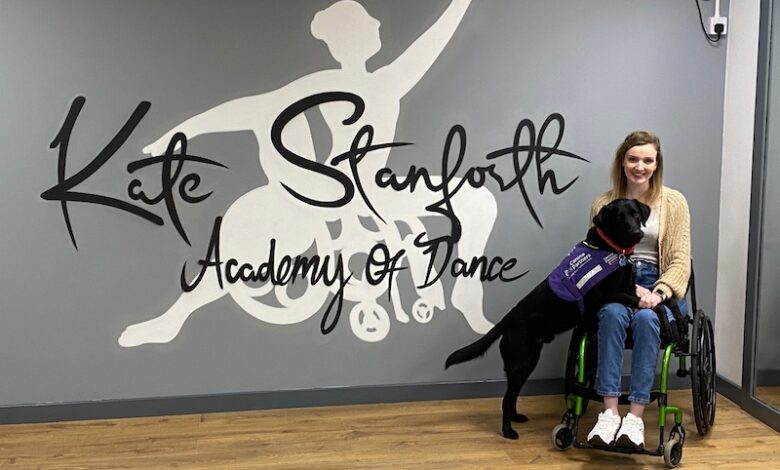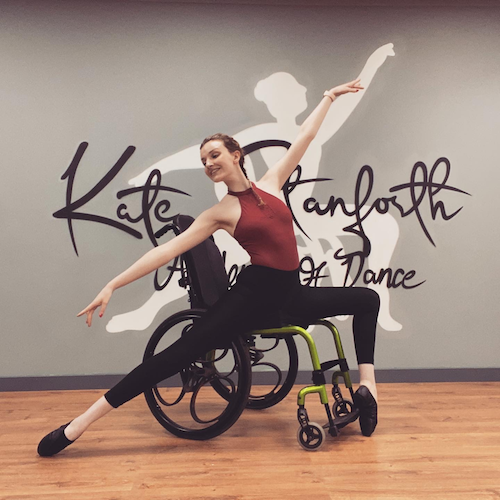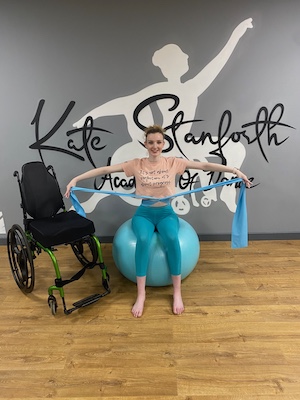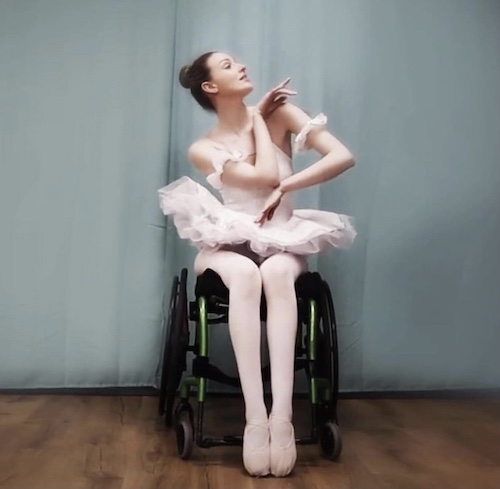
Kate Stanforth: disabled dance teacher empowering inclusive dance
Kate Stanforth is a dance teacher, charity founder, disability activist, model, and PR manager from Northumberland. When she became a wheelchair user, she made adaptations to dance in order to continue to pursue her passion and gain her teaching qualification. She now runs an inclusive dance school and encourages others to start their own exploration with dance, no matter their ability.
Our contributor, Rebecca Sullivan, got the opportunity to interview Kate Stanforth about her inspirations to become a dancer, her dance academy and how the dance industry can be more inclusive.
You can also get involved in dancing yourself with Kate’s how-to video on simple ballet techniques adapted for wheelchair users or anyone with reduced mobility.


Dance has been a passion of Kate’s since she was a child but had to give up her pre-professional dance training when she suddenly became ill.
At 14, Kate became a wheelchair user after being diagnosed with Ehlers-Danlos Syndromes (EDS) – a group of rare inherited conditions that affect connective tissue – plus a range of other health conditions.
However, her passion for dance has continued and her goal is to improve accessibility for disabled people, particularly in the dance industry. She now teaches from her wheelchair and specialises in inclusive dance classes.
She demonstrates alternative ways to perform different styles of dance. For example, using tap gloves for tap dance.
As a wonderful dancer herself, Kate show cases that the beauty of dance should be for everyone who wants to participate.
Kate has even set up her own online inclusive dance event with West End stars so that disabled people can have the same opportunity to dance with the stars, which of course, was all adapted and subtitled.
Kate also wants to encourage brands to be more inclusive, which led her to feature as one of the first ambulatory wheelchair users in a social media campaign dancing for George at ASDA in Miami.
Other dance highlights include filming with Channel 4, featuring as part for Tu Sainsbury’s advert, running her own class on Capezio’s page, and having her own mini documentary created.
Kate now has her own inclusive dance school called Kate Stanforth Academy Of Dance, in which she aims to build a community of dancers!
Public speaking is one of Kate’s other strengths and she has been at major charity events and made appearances on radio chat shows. She talks about the issues disabled people face and being a voice for many, whether that’s through writing or speaking.
She also has a regular column for Allied Mobility and has had published pieces in The Mighty, The Hexham Courant and Scope.
Furthermore, Kate has featured on TV and online with The Guardian, The One Show, ITV, Channel 4 and BBC Newcastle.
In addition, Kate set up her own charity, Project Parent,in 2014, which provides gift boxes to parents who have to stay in hospital over Christmas looking after their poorly child.
They often don’t receive anything and need a pick-me-up. It supports nine hospitals spanning from Newcastle down to Southampton and has donated over 1,500 boxes.
Read more about Kate Stanforth in her own words.


In your own words, how did you first learn that you could adapt dance to make it more accessible to you?
I first learned how to adapt dance through improvising. I was determined to get my teaching qualification and it was extremely difficult because there wasn’t much room for adaptation.
After I became a qualified teacher, I had the ability to start dancing for myself and I could look at moves and think “ok, that doesn’t work for me, so I’m going to do this instead”. I wish I had the confidence earlier on in my career to make the adaptations that worked for me and experiment, but I’m glad it’s got me where I am today.
You have now started teaching dance to other people with disabilities. Tell us a bit about your academy?
I set up the school because I love dance and I want to make the dance industry more accessible. I tried to break down all the barriers I had accessing dance as a disabled person.
Firstly, I film from an inclusive studio at Tumble Gymnastics and Activity Centre (in person classes to start once Covid allows!).
It’s incredibly hard to find accessible studios so I am so grateful to have a studio there with all my needs accommodated for.
I also offer my sessions online and adapt to each person’s needs, as well as recording each lesson so people can catch up at a later time if they’re not well. Finally, I want to build a community where we all have a safe space – that’s really important to me.
What have the responses been like from other disabled people who, perhaps, didn’t think they could participate in dance before?
It’s honestly been absolutely amazing. There’s one video that will always stay with me of a dancer, Reign, who managed to tap dance for the first time since becoming disabled with some tap gloves I made.
They smiled so much and I cry every time I watch that video. I make sure I have five minutes to chat after each session with my dancers and they’ve all given me some lovely feedback about how much the sessions help them, so I feel so privileged to teach such an incredible group of talented students.
As a disabled dancer, what do you find are the biggest barriers?
My health is like a rollercoaster but I’ve had a really tough time with it recently. With EDS, you often can’t even see on the outside what’s going on, but I’m on a six month treatment for an infection and just recovering from a cervical prolapse. It’s one thing after another and that’s what’s so exhausting.
Another thing that is really hard is simply breaking in, and being included in the industry. Not many brands/singers/shows want to feature disabled dancers – yet!
How do you think the dance industry can improve its inclusivity?
Hire us and pay us! That would be a good start. I mean, I would love more accessible dance studios, more training for dance teachers, easier access to equipment so disabled people can dance. There’s such a list. We have a long way to go but we are getting there.
What is your favourite thing about dancing and teaching dance?


The fact no matter how much of a bad day I’ve had, I smile through the session and my mind is focused. I focus on my breathing, my moves and what I’m here to do – dance.
You very honestly talk online about the more difficult days with your health conditions. In what ways do you find dance helps you on them days?
My health, like many of the dancers who attend my school, is difficult. I have come out of hospital and taught a lesson an hour later. I’ve taught a lesson lying down from my bed when my cervix collapsed. It’s all about adapting.
Dance always makes me focus and being with a group is such a supportive environment. We all check up on each other and it’s so lovely.
If a person is reading this and wants to give dancing a try but is perhaps a little apprehensive in doing so, what would you say to them?


You can always try free dance sessions online first or taster sessions. Remember, you aren’t signing up to be the next prima ballerina and especially at my dance school, things are really relaxed.
You can always contact your teacher beforehand to talk through any worries and give it a go, you never know, you might love it!
You can find out more about Kate Stanforth by visiting her website and following her on Twitter and Instagram.
Interview by Rebecca Sullivan
More on Disability Horizons…